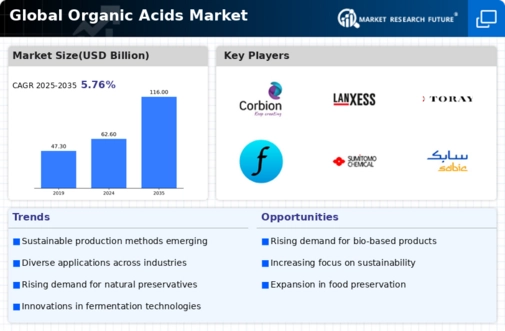Market Trends and Forecasts
Advancements in Biotechnology
Technological advancements in biotechnology are revolutionizing the production processes within the Global Organic Acids Market Industry. Innovations such as fermentation technology enhance the efficiency and yield of organic acid production, making it more cost-effective. For instance, the development of genetically modified microorganisms has enabled the production of organic acids at a larger scale. This technological evolution not only reduces production costs but also meets the increasing demand for organic acids across various sectors, thereby propelling market growth. As these advancements continue, they are likely to play a pivotal role in shaping the future of the organic acids market.
Increasing Health Consciousness
The rising health consciousness among consumers is influencing the Global Organic Acids Market Industry, particularly in the dietary supplements and functional foods sectors. Organic acids like acetic acid and citric acid are recognized for their health benefits, including antimicrobial properties and metabolic support. As consumers seek healthier alternatives, the demand for products containing organic acids is expected to rise. This trend is likely to bolster the market, with projections indicating a substantial increase in market value, potentially reaching 116.0 USD Billion by 2035. The health and wellness trend is thus a critical driver for the organic acids market.
Rising Applications in Food and Beverage
The food and beverage sector is a significant contributor to the Global Organic Acids Market Industry, utilizing organic acids as preservatives, flavor enhancers, and acidulants. Citric acid, for example, is widely used in soft drinks and processed foods. The market's expansion is supported by the increasing consumer inclination towards natural ingredients, which is driving manufacturers to incorporate organic acids into their products. This trend is anticipated to sustain the market's growth trajectory, with projections indicating a rise to 116.0 USD Billion by 2035, reflecting a robust CAGR of 5.76% from 2025 to 2035.
Growing Demand for Biodegradable Products
The increasing consumer preference for environmentally friendly products drives the Global Organic Acids Market Industry. As sustainability becomes a priority, industries are shifting towards biodegradable materials, which often incorporate organic acids. For instance, lactic acid, derived from renewable resources, is gaining traction in packaging and textiles. This trend is projected to contribute to the market's growth, with the Global Organic Acids Market expected to reach 62.6 USD Billion in 2024. The shift towards sustainable practices is likely to enhance the demand for organic acids, aligning with global efforts to reduce plastic waste.
Regulatory Support for Natural Ingredients
Regulatory frameworks promoting the use of natural ingredients are significantly impacting the Global Organic Acids Market Industry. Governments worldwide are implementing policies that favor the use of organic acids in food, cosmetics, and pharmaceuticals, recognizing their safety and efficacy. This regulatory support encourages manufacturers to adopt organic acids in their formulations, aligning with consumer preferences for natural products. As a result, the market is poised for growth, with expectations of reaching 62.6 USD Billion in 2024. The favorable regulatory landscape is likely to facilitate the expansion of organic acids across various applications.

























